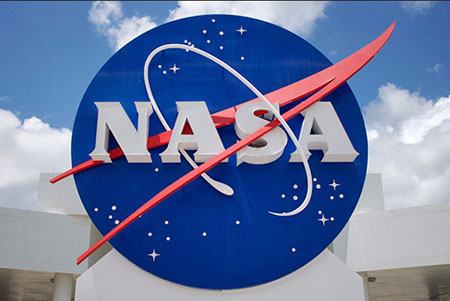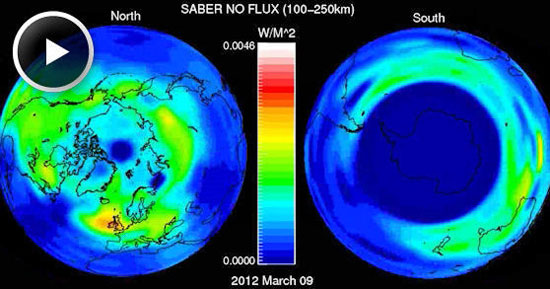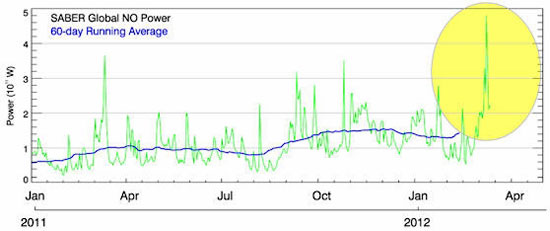|
Global Warming Debunked NASA New Discovery Proves Carbon Dioxide Cools Atmosphere
A recent NASA report throws the space agency into conflict with its climatologists after new NASA measurements prove that carbon dioxide acts as a coolant in Earth's atmosphere.
NASA's Langley Research Center has collated data proving that “greenhouse gases” actually block up to 95 percent of harmful solar rays from reaching our planet, thus reducing the heating impact of the sun.
The data was collected by Sounding of the Atmosphere using Broadband Emission Radiometry, (or SABER).
SABER monitors infrared emissions from Earth’s upper atmosphere, in particular from carbon dioxide (CO2) and nitric oxide (NO), two substances thought to be playing a key role in the energy balance of air above our planet’s surface.
NASA's Langley Research Center instruments show that the thermosphere not only received a whopping 26 billion kilowatt hours of energy from the sun during a recent burst of solar activity, but that in the upper atmospheric carbon dioxide and nitrous oxide molecules sent as much as 95% of that radiation straight back out into space.
The shock revelation starkly contradicts the core proposition of the so-called greenhouse gas theory which claims that more CO2 means more warming for our planet.
However, this compelling new NASA data disproves that notion and is a huge embarrassment for NASA's chief climatologist, Dr James Hansen and his team over at NASA's GISS.
Already, the International Panel on Climate Change (IPCC) has been in full retreat after having to concede a 17-year stall in global warming despite levels of atmospheric CO2 rising almost 40 percent in recent decades.
The new SABER data now forms part of a real world double whammy against climatologists' computer models that have always been programmed to show CO2 as a warming gas.
The SABER evidence also makes a mockery of the statement on the NASA GISS website (by Hansen underling Gavin Schmidt) claiming,
As NASA's SABER team at Langley admits:
Over at Principia Scientific International (PSI) greenhouse gas effect (GHE) critic, Alan Siddons is hailing the findings.
Siddons and his colleagues have been winning support from hundreds of independent scientists for their GHE studies carried out over the last seven years. PSI has proved that the numbers fed into computer models by Hansen and others were based on a faulty interpretation of the laws of thermodynamics.
PSI also recently uncovered long overlooked evidence from the American Meteorological Society (AMS) that shows it was widely known the GHE was discredited prior to 1951. [2]
Pointedly, a much-trumpeted new book released this month by Rupert Darwall claims to help expose the back story of how the junk GHE theory was conveniently resuscitated in the 1980's by James Hansen and others to serve an environmental policy agenda at that time. [3]
As the SABER research report states:
As PSI's own space scientists have confirmed, as solar energy penetrates deeper into our atmosphere, even more of its energy will end up being sent straight back out to space, thus preventing it heating up the surface of our earth.
The NASA Langley Research Center report agrees with PSI by admitting:
To those independent scientists and engineers at Principia Scientific International this is not news.
The “natural thermostat” effect of CO2 has long been known by applied scientists and engineers how have exploited it's remarkable properties in the manufacturer of refrigerators and air conditioning systems. The fledgling independent science body has repeatedly shown in it's openly peer reviewed papers that atmospheric carbon dioxide does not cause global warming nor climate change.
Some diehard climate alarmists will still say that in the lower atmosphere the action of carbon dioxide is reversed, but there is no actual proof of this at all. PSI suggests it is time for the SABER team to have a word with James Hansen.
Watch the full NASA video far below.
References
...into Earth's Upper Atmosphere from ScienceNASA Website
A recent flurry of eruptions on the sun did more than spark pretty auroras around the poles.
NASA-funded researchers say the solar storms of March 8th through 10th dumped enough energy in Earth’s upper atmosphere to power every residence in New York City for two years.
Solar Storms Dumps Gigawatts Earth's atmosphere lights up at infrared wavelengths during the solar storms of March 8-10, 2012. A ScienceCast video explains the physics of this phenomenon. Play it in below video!
SABER monitors infrared emissions from Earth’s upper atmosphere, in particular from carbon dioxide (CO2) and nitric oxide (NO), two substances that play a key role in the energy balance of air hundreds of km above our planet’s surface.
That’s what happened on March 8th when a coronal mass ejection (CME) propelled in our direction by an X5-class solar flare hit Earth’s magnetic field. (On the “Richter Scale of Solar Flares,” X-class flares are the most powerful kind.) Energetic particles rained down on the upper atmosphere, depositing their energy where they hit.
The action produced spectacular auroras around the poles and significant1 upper atmospheric heating all around the globe.
For the three day period, March 8th through 10th, the thermosphere absorbed 26 billion kWh of energy.
Infrared radiation from CO2 and NO, the two most efficient coolants in the thermosphere, re-radiated 95% of that total back into space.
A surge of infrared radiation from nitric oxide molecules on March 8-10, 2012, signals the biggest upper-atmospheric heating event in seven years.
Credit: SABER/TIMED.
See also the CO2 data.
This means the geomagnetic storm dumped enough energy into the atmosphere to power every home in the Big Apple for two years.
During the heating impulse, the thermosphere puffed up like a marshmallow held over a campfire, temporarily increasing the drag on low-orbiting satellites.
This is both good and bad. On the one
hand, extra drag helps clear space junk out of Earth orbit. On the
other hand, it decreases the lifetime of useful satellites by
bringing them closer to the day of re-entry.
More sunspots flinging more CMEs toward Earth adds up to more opportunities for SABER to study the heating effect of solar storms.
|



